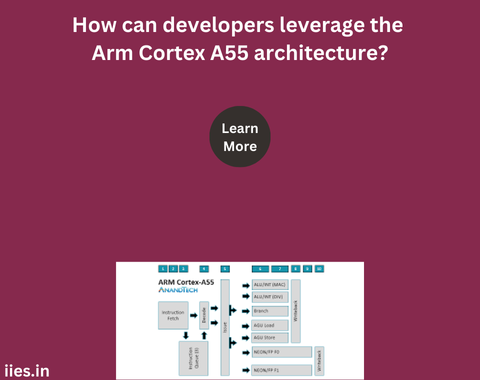
The ARM Cortex-A55 is a high-efficiency processor core designed to deliver an exceptional balance between performance and power efficiency. Part of ARM’s Cortex-A series, the Cortex-A55 is often employed in mid-range to high-end smartphones, tablets, and even embedded systems where energy efficiency is a priority. As developers, understanding the capabilities of the Cortex-A55 and how to leverage them can lead to optimized applications, better performance, and extended battery life in mobile devices.
The ARM Cortex-A55 is built on the ARMv8.2-A architecture, which introduces enhancements over its predecessors, such as improved memory access, better floating-point performance, and enhanced security features. The core design focuses on energy efficiency, making it ideal for devices where power consumption is critical. It is often used in big.LITTLE configurations, paired with higher-performance cores like the Cortex-A75 or Cortex-A76, allowing for dynamic performance scaling based on workload demands.
Energy Efficiency: The Cortex-A55 is designed with energy efficiency in mind. It consumes significantly less power than its predecessors while delivering comparable or better performance. This efficiency is achieved through various architectural improvements, including optimized instruction pipelines, reduced instruction cache misses, and better branch prediction.
Scalability: The Cortex-A55 can be scaled up to eight cores in a single cluster, allowing developers to design systems that balance performance and power consumption. This scalability is crucial for applications ranging from smartphones to IoT devices, where different performance levels are required.
Memory Access Improvements: The Cortex-A55 includes an enhanced memory subsystem with improved latency and bandwidth. This improvement is critical for applications that require quick access to large datasets, such as machine learning inference or high-resolution image processing.
Security Features: The Cortex-A55 supports ARM TrustZone technology, providing hardware-based security for sensitive data and operations. This feature is particularly important for applications involving financial transactions, personal data, or secure communications.
Advanced SIMD and Floating-Point Operations: The Cortex-A55 includes advanced SIMD (Single Instruction, Multiple Data) instructions and floating-point capabilities, making it suitable for tasks requiring parallel processing, such as multimedia processing, digital signal processing, and certain machine learning workloads.
To fully harness the capabilities of the ARM Cortex-A55, developers need to understand the architecture’s strengths and tailor their applications accordingly. Here are several strategies developers can use to optimize their software for the Cortex-A55:
Given the Cortex-A55’s emphasis on power efficiency, developers should focus on optimizing their applications to minimize energy consumption. This can be achieved by:
The Cortex-A55 can scale up to eight cores, providing significant multi-threading capabilities. Developers should design their applications to leverage this multi-core architecture:
Efficient memory access is crucial for achieving optimal performance on the Cortex-A55. Developers should focus on:
The Cortex-A55’s SIMD (Single Instruction, Multiple Data) capabilities allow for efficient parallel processing of data, which is particularly beneficial for multimedia applications:
The Cortex-A55’s support for ARM TrustZone technology provides a robust security framework:
The ARM Cortex-A55 is a versatile and powerful processor core that offers developers a range of opportunities to optimize their applications for performance and efficiency. By understanding and leveraging the architecture’s strengths—such as energy efficiency, multi-core scalability, enhanced memory access, SIMD capabilities, and robust security features—developers can create applications that not only perform well but also make the most of the hardware’s capabilities. Whether working on mobile devices, IoT solutions, or embedded systems, the Cortex-A55 provides a solid foundation for building high-performance, energy-efficient applications that meet the demands of modern users.
Indian Institute of Embedded Systems – IIES